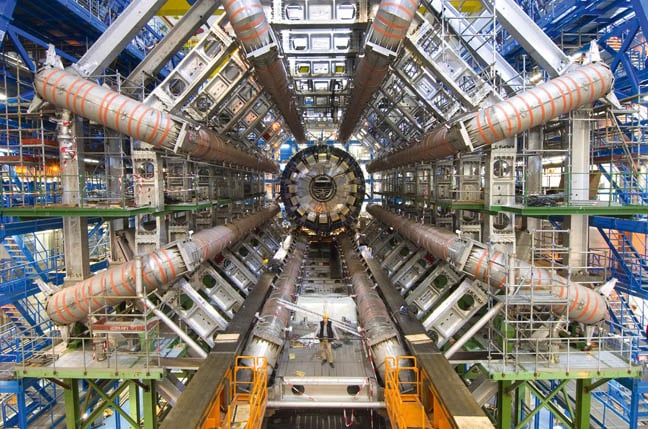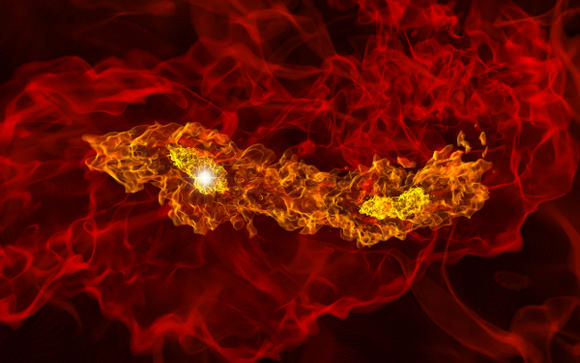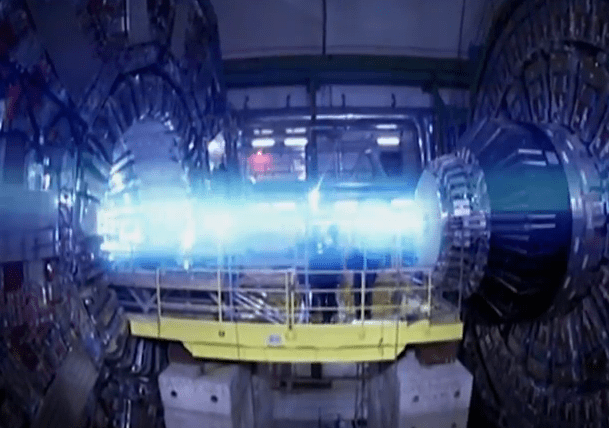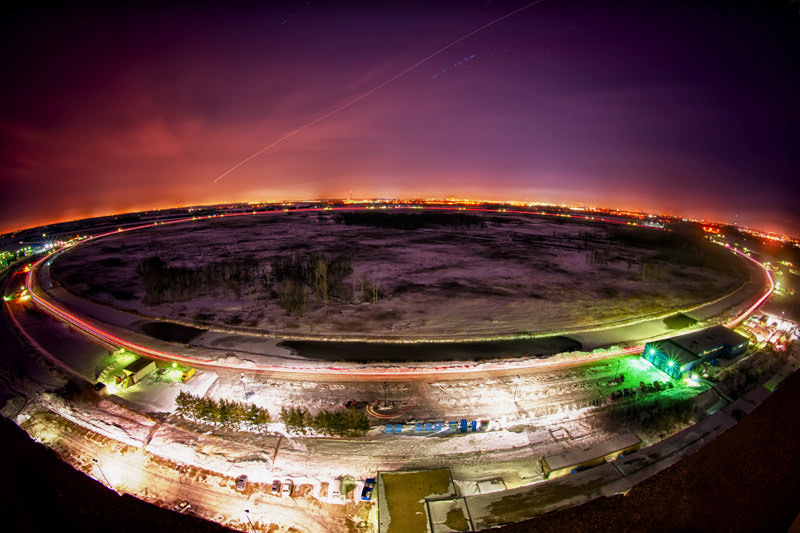Just like Isaac Newton, Galileo and Albert Einstein, I’m not sure exactly when I became aware of Peter Higgs. He has been one of those names that anyone who has even the slightest interest in science, especially physics, has become aware of at some point. Professor Higgs was catapulted to fame by the concept of the Higgs Boson – or God Particle as it became known. Sadly, this shy yet key player in the world of physics passed away earlier this month.
Continue reading “Peter Higgs Dies at 94”Higgs Boson Threatened The Early Universe, But Gravity Saved The Day
All the physical properties of our Universe – indeed, the fact that we even exist within a Universe that we can contemplate and explore – owe to events that occurred very early in its history. Cosmologists believe that our Universe looks the way it does thanks to a rapid period of inflation immediately before the Big Bang that smoothed fluctuations in the vacuum energy of space and flattened out the fabric of the cosmos itself.
According to current theories, however, interactions between the famed Higgs boson and the inflationary field should have caused the nascent Universe to collapse. Clearly, this didn’t happen. So what is going on? Scientists have worked out a new theory: It was gravity that (literally) held it all together.
The interaction between the curvature of spacetime (more commonly known as gravity) and the Higgs field has never been well understood. Resolving the apparent problem of our Universe’s stubborn existence, however, provides a good excuse to do some investigating. In a paper published this week in Physical Review Letters, researchers from the University of Copenhagen, the University of Helsinki, and Imperial College London show that even a small interaction between gravity and the Higgs would have been sufficient to stave off a collapse of the early cosmos.
The researchers modified the Higgs equations to include the effect of gravity generated by UV-scale energies. These corrections were found to stabilize the inflationary vacuum at all but a narrow range of energies, allowing expansion to continue and the Universe as we know it to exist… without the need for new physics beyond the Standard Model.
This new theory is based on the controversial evidence of inflation announced by BICEP2 earlier this summer, so its true applicability will depend on whether or not those results turn out to be real. Until then, the researchers are hoping to support their work with additional observational studies that seek out gravitational waves and more deeply examine the cosmic microwave background.
At this juncture, the Higgs-gravity interaction is not a testable hypothesis because the graviton (the particle that handles all of gravity’s interactions) itself has yet to be detected. Based purely on the mathematics, however, the new theory presents an elegant and efficient solution to the potential conundrum of why we exist at all.
The Face of Creation
The latest autotuned installment in John D. Boswell’s Symphony of Science series waxes melodic about the particle-smashing science being done with the Large Hadron Collider at CERN, in particular its search for the Higgs boson, a.k.a. the… ok, ok, I won’t say it…
“We can recreate the conditions that were present just after the beginning of the Universe.”
– Prof. Brian Cox, “The Face of Creation”
John has been entertaining science fans with his Symphony mixes since 2009, when his first video in the series — “A Glorious Dawn” featuring Carl Sagan — was released. Now John’s videos are eagerly anticipated by fans, who follow him on YouTube and on Twitter as @melodysheep.
I’d have to say my all-time favorite is “Onward to the Edge”, featuring astrophysicist Neil deGrasse Tyson, Professor Brian Cox and Carolyn Porco from the Cassini imaging team.
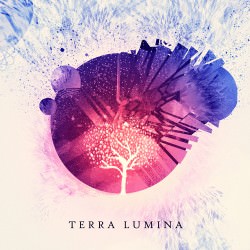 Thanks to some help from Kickstarter, John has recently released an original album, Terra Lumina, a “collection of folk/rock songs with themes including gravity, geology, photons, and the Doppler effect.” It’s a unique musical take on some of science’s most amazing discoveries, from John D. Boswell and vocalist William Crowley. Check out the video trailer here.
Thanks to some help from Kickstarter, John has recently released an original album, Terra Lumina, a “collection of folk/rock songs with themes including gravity, geology, photons, and the Doppler effect.” It’s a unique musical take on some of science’s most amazing discoveries, from John D. Boswell and vocalist William Crowley. Check out the video trailer here.
The album can be found on Amazon and on iTunes.
Videos via melodysheep
Ping-Pong Particles: What the Higgs Does
Unless you’ve been hiding under a chondrite for the past week you’ve heard the news from CERN regarding the discovery of a new particle that exhibits “Higgs-like” qualities. Particle physics isn’t the easiest discipline to wrap one’s head around, and while we’ve recently shared some simplified explanations of what exactly a Higgs boson is, well…here’s another.
Here, BBC’s Jonathan Amos attempts to demonstrate what the Higgs field does, and what part the boson plays. Some Ping-Pong balls, a little sugar, and a cafeteria tray is all it takes to give an idea of how essential this long-sought after subatomic particle is to the Universe. (If only finding it had been that easy!)
Video: BBC News
What’s a Higgs Boson, Anyway?
With the science world all abuzz in anticipation of tomorrow’s official announcement from CERN in regards to its hunt for the Higgs, some of you may be wondering, “what’s a Higgs?” And for that matter, what’s a boson?
The video above, released a couple of months ago by the talented Jorge Cham at PHDcomics, gives a entertaining run-down of subatomic particles, how they interact and how, if it exists — which, by now, many are sure it does — the Higgs relates to them.
It’s the 7-minutes course in particle physics you’ll wish you had taken in college (unless you’re a particle physicist in which case… well, you’d still probably have enjoyed it.)
Credit: PHDcomics.com
Tevatron Targets Higgs Mass
Today, researchers from Fermilab announced they have zeroed in further on the mass of the Higgs boson, the controversially-called “God particle”* that is thought to be the key to all mass in the Universe. This news comes just two days before a highly-anticipated announcement by CERN during the ICHEP physics conference in Melbourne, Australia (which is expected by many to confirm actual proof of the Higgs.)
Even after analyzing the data from 500 trillion collisions produced over the past decade at Fermilab’s Tevatron particle collider the Higgs particle has not been identified directly. But a narrower range for its mass has been established with some certainty: according to the research the Higgs, if it exists, has a mass between 115 and 135 GeV/c2.
“Our data strongly point toward the existence of the Higgs boson, but it will take results from the experiments at the Large Hadron Collider in Europe to establish a discovery,” said Fermilab’s Rob Roser, cospokesperson for the CDF experiment at DOE’s Fermi National Accelerator Laboratory.
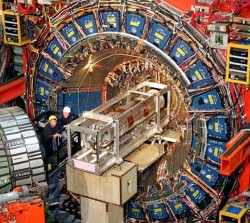 Researchers hunt for the Higgs by looking for particles that it breaks down into. With the Large Hadron Collider at CERN, scientists look for energetic photons, while at Fermilab CDF and DZero collaborators have been searching for bottom quarks. Both are viable results expected from the decay of a Higgs particle, “just as a vending machine might return the same amount of change using different combinations of coins.”
Researchers hunt for the Higgs by looking for particles that it breaks down into. With the Large Hadron Collider at CERN, scientists look for energetic photons, while at Fermilab CDF and DZero collaborators have been searching for bottom quarks. Both are viable results expected from the decay of a Higgs particle, “just as a vending machine might return the same amount of change using different combinations of coins.”
Fermilab’s results have a statistical significance of 2.9 sigma, meaning that there’s a 1-in-550 chance that the data was the result of something else entirely. While a 5-sigma significance is required for an official “discovery”, these findings show that the Higgs is running out of places to hide.
“We have developed sophisticated simulation and analysis programs to identify Higgs-like patterns,” said Luciano Ristori, co-spokesperson of the CDF experiment. “Still, it is easier to look for a friend’s face in a sports stadium filled with 100,000 people than to search for a Higgs-like event among trillions of collisions.”
“We achieved a critical step in the search for the Higgs boson. Nobody expected the Tevatron to get this far when it was built in the 1980s.”
– Dmitri Denisov, DZero cospokesperson and physicist at Fermilab
Nearly 50 years since it was proposed, physicists may now be on the edge of exposing this elusive and essential ingredient of… well, everything.
See the Fermilab press release here.
Read Fermilab’s FAQs on the Higgs boson
Top image: The Tevatron typically produced about 10 million proton-antiproton collisions per second. Each collision produced hundreds of particles. The CDF and DZero experiments recorded about 200 collisions per second for further analysis. Sub-image: The three-story, 6,000-ton CDF detector recorded snapshots of the particles that emerge when protons and antiprotons collide.(Fermilab)
*And why is it often called the God particle? Because of this book.
What is CERN?
Here’s another great video from Sixty Symbols featuring professor Ed Copeland giving his entertaining description of CERN, the “Mecca for physicists” and home of the famous Large Hadron Collider. (Hopefully it will tide you over until the latest news is presented on July 4 regarding the ongoing hunt for the ever-elusive Higgs field!) Enjoy.
“On each of these experiments there are something like 3,000 physicists involved. So they’re not all here at the same time, of course… the cafeteria would be a nightmare if that was the case.”
– Prof. Ed Copeland
Brilliant.

